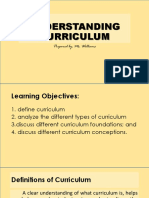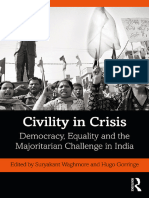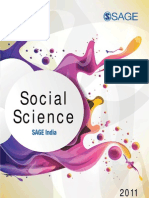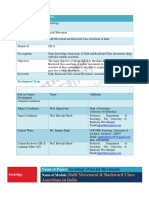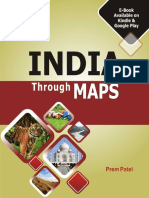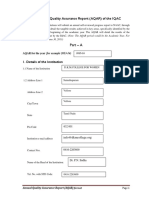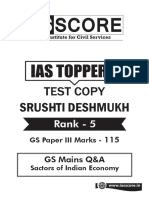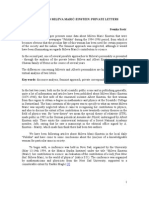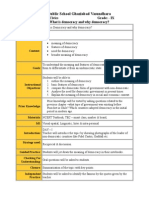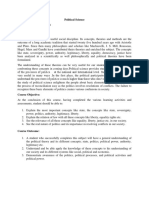Surinder S. Jodhka, Caste in Contemporary India: South Asia Multidisciplinary Academic Journal
Surinder S. Jodhka, Caste in Contemporary India: South Asia Multidisciplinary Academic Journal
Uploaded by
azamCopyright:
Available Formats
Surinder S. Jodhka, Caste in Contemporary India: South Asia Multidisciplinary Academic Journal
Surinder S. Jodhka, Caste in Contemporary India: South Asia Multidisciplinary Academic Journal
Uploaded by
azamOriginal Title
Copyright
Available Formats
Share this document
Did you find this document useful?
Is this content inappropriate?
Copyright:
Available Formats
Surinder S. Jodhka, Caste in Contemporary India: South Asia Multidisciplinary Academic Journal
Surinder S. Jodhka, Caste in Contemporary India: South Asia Multidisciplinary Academic Journal
Uploaded by
azamCopyright:
Available Formats
South Asia Multidisciplinary Academic
Journal
Book Reviews
Surinder S. Jodhka, Caste in Contemporary India
Alexandra de Heering
Electronic version
URL: http://journals.openedition.org/samaj/4089
ISSN: 1960-6060
Publisher
Association pour la recherche sur l'Asie du Sud (ARAS)
Electronic reference
Alexandra de Heering, « Surinder S. Jodhka, Caste in Contemporary India », South Asia Multidisciplinary
Academic Journal [Online], Book Reviews, Online since 04 March 2016, connection on 01 May 2019.
URL : http://journals.openedition.org/samaj/4089
This text was automatically generated on 1 May 2019.
This work is licensed under a Creative Commons Attribution-NonCommercial-NoDerivatives 4.0
International License.
Surinder S. Jodhka, Caste in Contemporary India 1
Surinder S. Jodhka, Caste in
Contemporary India
Alexandra de Heering
REFERENCES
Jodhka, Surinder S. (2015) Caste in Contemporary India, New Delhi: Routledge, 252 pages.
South Asia Multidisciplinary Academic Journal , Book Reviews
Surinder S. Jodhka, Caste in Contemporary India 2
1 Do we need yet another book on castes?
Although to all appearances provocative,
this is the question that might come to
mind when browsing through Surinder
Jodhka’s latest publication, Caste in
Contemporary India. Hugo Gorringe (2014),
in his review of the same book, also
foresees people will wonder what is the
point of publishing another book on caste.
Which fresh perspectives does Surinder
Jodhka, a professor of sociology and chair
of the Centre for the Study of Social
Systems at the Jawaharlal Nehru University
(Delhi), bring to the topic?
2 The reason for being of this monograph—
the result of the research Jodhka
conducted on caste over the last 15 years in
the context of different projects carried
out in various regions, although mostly in
North India—lies in its treatment of the
issue of castes: challenging many flawed
conceptions of the reality of caste (caste as a contemporary incongruity, an
anachronism), it attempts to rectify the sociology of democratic politics. In the author’s
opinion, the popular fallacies largely prevailing among the middle class in India
(Jodhka 2015: xiiv and 218), or within the scholarship on the topic, have gone on long
enough. It is time to cripple them. No, unlike many evolutionary theorists have predicted,
caste did not inevitably disappear with the dawn of modernity and development. No,
caste in modern India is not dead. Neither is caste merely surviving because it has been
artificially kept alive by the media and government policies, as some have been trying to
advocate. Jodhka challenges these commonsensical formulations. Far from dying off or
even just surviving, caste has shown a tremendous resilience and a strong ability to adapt
to the fast-changing society of India. Its organization is evolving, its hierarchical logic is
declining but it indisputably continues to exist as a constantly renewed form of relational
discrimination and domination, always more visible, always more complex.
3 Surinder Jodhka insists on the importance of the way the ‘caste question’ is framed since
it heavily influences the kind of data collected and therefore also the results obtained. As
stated in an introduction on caste he published a couple of years earlier, ‘the meaning
and experience of caste changes, depending upon whose experience of caste is given
priority’ (Jodhka 2012: 170). Precisely because viewing caste as a tradition, or as a form of
power—as was usually the case until the 1990’s—silences the many discriminations
emanating from this social structure, Jodhka emphasizes the relevancy, not to say the
necessity, of generalizing the conceptualization of caste within the framework of
prejudice and discrimination, i.e. to look at caste ‘as a system that institutionalizes
humiliation as a social and cultural practice’ (2015: 12). This socially-engaged stance,
which differs radically from other rather theoretical approaches that have long
dominated the scholarship on caste, can however not be labelled as new. It follows in the
footsteps of research in the field of Dalit studies conducted with the ‘perspective from
South Asia Multidisciplinary Academic Journal , Book Reviews
Surinder S. Jodhka, Caste in Contemporary India 3
below’ for over 20 years and approaching power critically (Zelliot 1992, Omvedt 1995,
Kandyil 2009, Teltumbde 2010).
4 Caste in Contemporary India is a compilation of seven articles previously published and is
divided into three parts. The first part, entitled ‘Hierarchies and the Politics of
Citizenship’, basically undertakes to draw a panorama of the Dalits’ situation in today’s
(North) India. After underlining ‘the vestiges of untouchability in rural Punjab’
(chapter 1), Jodhka investigates the upsurge of atrocities against Dalits in Punjab and
Haryana (chapter 2) as well as the politicization of caste and the emergence of a Dalit
movement (chapter 3). The second part, dealing with the question of ‘Caste in the Neo-
Liberal Economy’, focuses on the persisting weight of caste in the expanding private
sector. This second part is, in my opinion, the most persuasive. After the liberalization of
the country in the 1990s, the State’s withdrawal from its direct involvement in the
economy, combined with increasing privatization all over the country, had an important
impact on the existence of historically marginalized groups who, for a few decades
already, had been moving away from the traditional agrarian economy. As per capitalist
theory, individuals should be judged in the light of their skills and their merit; but does
this ideal rule—according to which the social identities (caste) of agents do not matter in
the market—apply to the Indian context? This section addresses this question in the
business sector (chapter 4 on Dalit entrepreneurs) as well as in the corporate world
(chapter 5 on the recruitment process). In both cases, the answers provided, not only by
Dalits entrepreneurs themselves but also by upper-caste Human Resource employees,
confirm that the ideal scenario of inclusion is far from actual experience. Many obstacles
lie on the path towards Dalit mobility. Dalit entrepreneurs, whose socio-demographic
data are meticulously described here, look back on the multiple hardships they had, and
still have, to go through because of their lack of resources and prevalent caste prejudice.
As in the corporate sector, despite a strong politics of stonewalling with regard to caste
(caste is a taboo in many spheres of Indian society) where merit is systematically
presented as being the only guiding rule, Jodhka’s questions (for instance: ‘what [do you]
look for in addition to merit?’ (Jodhka 2015: 127) enabled him to uncover the actual
recruitment rationale. He demonstrates that ‘though the hiring managers underlined
merit as the sole criteria in the selection process, the standards for judging the soft skills
of the candidates invariably drew from their cultural prejudices about the communities
and regions the candidates came from’ (p. 131). Caste-blindness is—essentially—a
rhetoric; reality, as revealed in this study, is far from being ideal.1 The third, and last part
is entitled ‘Mobility and Mobilizations’ and looks—to put it briefly—at the history and the
logics of mobilization in two different locations and at different periods of time: Punjab
and Delhi. Chapter 6, on Punjab, provides an outline of the ‘global contours of Ravidasi
identity’ while chapter 7 investigates the background and the motivations of Dalit
activists in Delhi.
5 While acknowledging the reproduction of the institution of caste in contemporary India,
this volume emphasizes the many radical changes it has undergone in the last few
decades. Three types of changes are distinguished: those coming ‘from below’, that is
from low-caste social movements, those ‘from above’, i.e. constitutional provisions or
state policies in favour of the victims of discrimination, and changes ‘from the side’, i.e.
changes that were not directly targeted at the emancipation of low-caste people but that
had an impact on them eventually (p. 216). The attention paid to diachrony, historical
changes and social transformations, as well as their careful analysis, is of great value.
South Asia Multidisciplinary Academic Journal , Book Reviews
Surinder S. Jodhka, Caste in Contemporary India 4
Transformations on one side, and increasing resistance to change on the other, are part
of a multifaceted interweaving of humiliation, eagerness for self-respect, privileges,
domination, which Jodhka attempts to bring forward. For that matter, the author
grounds his work in intensive fieldwork and in strong empirical (quantitative and
qualitative) evidence that fruitfully keeps his intellectual engagement from becoming
purely theoretical. He is searching for the ‘reality of caste, as it has been lived and
experienced on ground’ (p. xiv). The diversity of the field sites explored (Punjab, Haryana,
Uttar Pradesh, Delhi) offers a fertile ground for comparison. Very few studies have been
carried out on Punjabi Dalits. As other scholars have done with other religious minorities
(such as Mines 1978 and Mosse 2012, for instance), Jodhka contributes to fill the void
concerning the practices of caste within the Sikh community.
6 Yet, despite its many abovementioned strengths, its erudition (while remaining highly
readable) and the author’s laudable effort to bring out a common thread through a solid
introduction and conclusion, this compilation leaves an uncomfortable impression of
unevenness and heterogeneity. The apparent consistency found in the well-structured
table of content is not maintained throughout the book. It, therefore, does not fully
succeed at convincing the reader about the relevancy of the compilation of the articles.
Some chapters are individually enlightening but as an entity, this volume is a bit
disappointing.
7 As often in compilations, the common thread does not appear clearly. Despite Jodhka’s
efforts to formulate it, a solid binder is missing. Overarching section titles do not suffice
to bring coherence. This impression certainly results from the fact that the articles were
written in the context of successive research projects that seemingly did not follow much
linearity, nor a common aim (an ‘order’ for an NGO, a World Bank-funded project,
personal projects, etc.). The title of the book itself ‘Caste in Contemporary India’ is
misleading, and leads to disappointment: is a book on castes in India even possible? As
mentioned by the author himself, ‘each and every corner of the country, each and every
region has its own specificities’ (Jodhka 2015: 25). The choice of the title probably results
from editorial and marketing constraints, but why fall into the trap of speaking about
‘India’ as an entity experiencing the reality of caste homogeneously? Wouldn’t it have
been wiser to be more specific and speak, at least, of North India?
8 Lastly, although all seven chapters deal explicitly with, and show a genuine concern for,
Dalit issues, this book is simply presented as a book on caste. Of course, the caste system
is the overarching framework at the root of the immense disparities between social
groups but why not clearly present it as a book on Dalits? Dalits struggle nowadays to be
called by the right name—that is using a name that specifies their social and mental
oppression (Paik 2011)—, to be granted attention, and to have their condition of
deprivation known and recognized. They also fight for the recognition of the changes
that have taken place in the last decades. This publication, underlining line after line the
importance of looking at the issue of caste from below, i.e. from the perspective of
discriminations, surprisingly fails to deal with the basics. Dalits, being the main subject of
this book, would have deserved to be given their proper name, that is to be put at the
forefront, up into the title line. However secondary this remark may seem, symbols
matter; all the more so when it comes to dealing with a long discriminated against and
silenced section of the population. To quote Albert Camus’ (2008: 908) famous formula: ‘to
call things by incorrect names is to add to the world’s misery’2 and, by extension, to deny
our humanity.
South Asia Multidisciplinary Academic Journal , Book Reviews
Surinder S. Jodhka, Caste in Contemporary India 5
9 To answer the question this review started with: yes this additional book on ‘caste’ and on
Dalits can be useful. It opens up new areas of reflection by adopting an interesting
approach. Preconceived ideas on caste must be crushed. It meticulously draws its
material from impressive fieldwork and always remains extremely readable. Overall
therefore, and when analysing each chapter individually, this compilation—which could
also be called a retrospective on Jodhka’s work—contributes greatly to Dalit studies and
explores important issues. However, as stated above, a more coherent approach with
clearer links between the chapters would have been appreciated, as well as a more
specific way of naming people.
BIBLIOGRAPHY
Camus, Albert (2008) Œuvres complètes (t. I), Paris: Gallimard Pléiade.
Gorringe, Hugo (2014) ‘Surinder S. Jodhka, Caste in Contemporary India’, Economic and Political
Weekly, XLIX(48), pp. 27–29.
Jodhka, Surinder (2012) Caste: Oxford India Short Introductions, New Delhi: Oxford University Press.
Kandyil, Achuthan M. (2009) Writing Indian History: A View from Below, Kolkata: Samya.
Mines, Mattison (1978) ‘Social Stratification among Muslim Tamils in Tamil Nadu, South India’, in
Imtiaz Ahmad (ed.), Caste and Social Stratification among Muslims in India, New Delhi: Manohar,
pp. 159–69.
Mosse, David (2012) The Saint in the Banyan Tree: Christianity and Caste Society in India, Berkeley:
University of California Press.
Omvedt, Gail (1995) Dalit Visions: The Anti-Caste Movement and the Construction of an Indian Identity,
Bombay, Calcutta: Orient Longman.
Prakash, Aseem (2015) Dalit Capital: State, Markets and Civil Society in Urban Cities, New Delhi:
Routledge.
Teltumbde, Anand (2010) The Persistence of Caste: The Khairlandji Murders and India’s Hidden
Apartheid, New Delhi: Navayana.
Zelliot, Eleanor (1992) From Untouchable to Dalit: Essays on Ambedkar Movement, Delhi: Manohar.
NOTES
1. The question of Dalit entrepreneurship in India has been addressed recently by Aseem Prakash
(2015) for instance.
2. In French: ‘Mal nommer les choses, c’est ajouter au malheur du monde’. Actually, the paternity of
this formula is debated and some attribute it to his dear friend André Derain.
South Asia Multidisciplinary Academic Journal , Book Reviews
Surinder S. Jodhka, Caste in Contemporary India 6
AUTHORS
ALEXANDRA DE HEERING
University of Namur, French Institute of Pondicherry
South Asia Multidisciplinary Academic Journal , Book Reviews
You might also like
- CAPE Sociology For Caribbean StudentsDocument532 pagesCAPE Sociology For Caribbean StudentsKelly Singh75% (4)
- Lingoda ClassDocument34 pagesLingoda ClassGareth GriffithsNo ratings yet
- Surinder S. Jodhka, Introduction, Caste in Contemporary IndiaDocument20 pagesSurinder S. Jodhka, Introduction, Caste in Contemporary IndiaRaisa Lorraine Palatty100% (2)
- Hkdse English Marking GuidelinesDocument4 pagesHkdse English Marking GuidelinesYING YUNo ratings yet
- Dalits in India, Manusmriti and Samkhya PhilosophyFrom EverandDalits in India, Manusmriti and Samkhya PhilosophyRating: 3 out of 5 stars3/5 (2)
- Reproductive Rights: An Unacknowledged Casualty of Conflict in Sri LankaDocument162 pagesReproductive Rights: An Unacknowledged Casualty of Conflict in Sri LankawmcsrilankaNo ratings yet
- Understanding Curriculum: Prepared By: Ms. WilliamsDocument24 pagesUnderstanding Curriculum: Prepared By: Ms. WilliamsAngel Laica Gamo Perez100% (2)
- DepEd Prescribed IPCRF Parts 1-4 SY 2019-2020Document14 pagesDepEd Prescribed IPCRF Parts 1-4 SY 2019-2020joel rosal92% (123)
- 03.2b HANDOUT - Cambridge IGCSE 511 Informal Letters - RubricDocument4 pages03.2b HANDOUT - Cambridge IGCSE 511 Informal Letters - RubricSpenser LemaichNo ratings yet
- Surinder S Jodhka - Caste in Contemporary India Routledge 2019 22092023 103901amDocument275 pagesSurinder S Jodhka - Caste in Contemporary India Routledge 2019 22092023 103901amHussain Khan NiaziNo ratings yet
- Statement of Research ProblemDocument5 pagesStatement of Research ProblemshivamNo ratings yet
- Dalit Movement and Backward Class Assertions in IndiaDocument14 pagesDalit Movement and Backward Class Assertions in IndiaSangram007No ratings yet
- Dalits in India: From Marginalisation To Inclusion: SSRN Electronic Journal April 2016Document15 pagesDalits in India: From Marginalisation To Inclusion: SSRN Electronic Journal April 2016SAILESHNo ratings yet
- International Sociology: Untouchability in Modern IndiaDocument12 pagesInternational Sociology: Untouchability in Modern IndiaTulula JamesNo ratings yet
- Shashwat Dwivedi.. ADocument15 pagesShashwat Dwivedi.. ASiddhant KumarNo ratings yet
- DALIT MOVEMENT IN INDIADocument25 pagesDALIT MOVEMENT IN INDIAbijaysandha96No ratings yet
- Socio RP 4th SemDocument17 pagesSocio RP 4th SemAditya JunejaNo ratings yet
- Casteism, Anti-Brahmin Movements and Indian PoliticsDocument16 pagesCasteism, Anti-Brahmin Movements and Indian PoliticsSangram007100% (1)
- Surinder S. Jodhka - Aseem Prakash - The Indian Middle Class-Oxford University Press (2016)Document74 pagesSurinder S. Jodhka - Aseem Prakash - The Indian Middle Class-Oxford University Press (2016)rushikeshgodse505No ratings yet
- (Ge) Political Science Human Right Part-1 Eng.Document155 pages(Ge) Political Science Human Right Part-1 Eng.noxar10515No ratings yet
- Communalism, Regionalism, Secularism Social Empowerment Salient Features of Indian Society Diversity of IndiaDocument3 pagesCommunalism, Regionalism, Secularism Social Empowerment Salient Features of Indian Society Diversity of IndiamishtiNo ratings yet
- Sociology Ias DreamDocument75 pagesSociology Ias DreamRajiv BehlNo ratings yet
- Mindsofcasteeditorialanthropologytoday PDFDocument4 pagesMindsofcasteeditorialanthropologytoday PDFakshayppNo ratings yet
- Mindsofcasteeditorialanthropologytoday PDFDocument4 pagesMindsofcasteeditorialanthropologytoday PDFakshayppNo ratings yet
- Mindsofcasteeditorialanthropologytoday PDFDocument4 pagesMindsofcasteeditorialanthropologytoday PDFakshayppNo ratings yet
- Suryakant Waghmore - Hugo Gorringe - Civility in Crisis - Democracy, Equality and The Majoritarian Challenge in India (2020, Routledge) - Libgen - LiDocument191 pagesSuryakant Waghmore - Hugo Gorringe - Civility in Crisis - Democracy, Equality and The Majoritarian Challenge in India (2020, Routledge) - Libgen - LiartcollectiveNo ratings yet
- Samaj 4745Document18 pagesSamaj 4745Neha Yadav 1No ratings yet
- Lokayata: Journal of Positive Philosophy, Vol - III, No.01 (March 2013)Document118 pagesLokayata: Journal of Positive Philosophy, Vol - III, No.01 (March 2013)The Positive PhilosopherNo ratings yet
- SocioeconomicDocument25 pagesSocioeconomicKrish AgrawalNo ratings yet
- SocialscDocument68 pagesSocialscmirahmedNo ratings yet
- Caste - MarxismDocument34 pagesCaste - MarxismAjayPandeyNo ratings yet
- Caste in Globalisation Context The Perception of IDocument14 pagesCaste in Globalisation Context The Perception of IAKRITI SINHANo ratings yet
- 1 Vokkaliga Goudas of Tamilnadu - A Historical StudyDocument9 pages1 Vokkaliga Goudas of Tamilnadu - A Historical StudyMuthuvel GaneshNo ratings yet
- Sociology2012 13Document80 pagesSociology2012 13Rajesh DharamsothNo ratings yet
- Caste Based Inequality, Exclusion and Social Change in IndiaDocument9 pagesCaste Based Inequality, Exclusion and Social Change in IndiaDheeraj Pratap MitraNo ratings yet
- Book ReviewDocument3 pagesBook ReviewNouman Alam SiddiquiNo ratings yet
- 2733 Subedi CasteDocument18 pages2733 Subedi Castepattabi8No ratings yet
- Social Change in Indian SocietyDocument26 pagesSocial Change in Indian SocietyMujeebu Rahman Vazhakkunnan100% (2)
- Dalit Movements in India: A Perspective From The BelowDocument25 pagesDalit Movements in India: A Perspective From The BelowAbhiNo ratings yet
- Caste in Question Identity or Hierarchy Contributions To Indian Sociology Occasional Studies 12Document278 pagesCaste in Question Identity or Hierarchy Contributions To Indian Sociology Occasional Studies 12Vishnu Sharma100% (3)
- Contextualization of Indian SociologyDocument36 pagesContextualization of Indian Sociologysoumita2508No ratings yet
- The_Caste_Question_Dalits_and_the_Politi (2)Document5 pagesThe_Caste_Question_Dalits_and_the_Politi (2)gayatriranjwe11No ratings yet
- Project Muse 528116Document25 pagesProject Muse 528116notsagorikaNo ratings yet
- Securalism and ChallengesDocument52 pagesSecuralism and ChallengesPrinsu SenNo ratings yet
- Masculinity - INDIADocument36 pagesMasculinity - INDIAsmrithiNo ratings yet
- Issue No.43 July 2021 18 29Document12 pagesIssue No.43 July 2021 18 29sssmriti2001No ratings yet
- Dalit Reconfiguration of Caste PDFDocument16 pagesDalit Reconfiguration of Caste PDFppingNo ratings yet
- Dalit Reconfiguration of Caste PDFDocument16 pagesDalit Reconfiguration of Caste PDFsatyanarayana k100% (1)
- Gender Biasness in Participation in Indian PoliticDocument17 pagesGender Biasness in Participation in Indian PoliticrlbarrantesNo ratings yet
- Block 4Document38 pagesBlock 4richaNo ratings yet
- Development of Sociology in IndiaDocument7 pagesDevelopment of Sociology in IndiaMuskan Khatri50% (2)
- Bodh Gaya BrochureDocument28 pagesBodh Gaya BrochureSandeep TiwariNo ratings yet
- Jodhka Caste Book IntroductionDocument18 pagesJodhka Caste Book Introductionolena.buianovaNo ratings yet
- Dalit Movement and Backward Class Assertions in India PDFDocument14 pagesDalit Movement and Backward Class Assertions in India PDFSangram007100% (1)
- The Sub-Categorization Movement of The Scheduled CastesDocument7 pagesThe Sub-Categorization Movement of The Scheduled CastesSukanya GroverNo ratings yet
- Social Integration and Caste in India: An Analytical StudyDocument20 pagesSocial Integration and Caste in India: An Analytical StudyIshika JainNo ratings yet
- India - Untouched Film ReviewDocument6 pagesIndia - Untouched Film Reviewgarvitpandit1344No ratings yet
- Empathy of Power and Effect On Knowledge Perspectives From Dalit StudiesDocument11 pagesEmpathy of Power and Effect On Knowledge Perspectives From Dalit StudiesAsit SarkarNo ratings yet
- Communal KeralaDocument4 pagesCommunal KeralaThahir Jamal KMNo ratings yet
- Dalit Movements in India and The Role of Ambedkar: Dr. Garima DhankharDocument4 pagesDalit Movements in India and The Role of Ambedkar: Dr. Garima DhankharJitu sahuNo ratings yet
- Dipankar Gupta's Dairy NoteDocument7 pagesDipankar Gupta's Dairy NoteRamesh KumarNo ratings yet
- Dalit Politics in India in The Times of HindutvaDocument13 pagesDalit Politics in India in The Times of HindutvaDiksha KachareNo ratings yet
- Rajni Kothari (Editor) - Caste in Indian Politics (1985, Sangam Books LTD) - Libgen - LiDocument400 pagesRajni Kothari (Editor) - Caste in Indian Politics (1985, Sangam Books LTD) - Libgen - LiLov KrNo ratings yet
- Govinda Chandra Rath Tribal Development in India TDocument3 pagesGovinda Chandra Rath Tribal Development in India Tmanox7679No ratings yet
- Dr. Ram Manohar Lohiya National Law University, Lucknow: B.A.L.L.B. (Hons.)Document13 pagesDr. Ram Manohar Lohiya National Law University, Lucknow: B.A.L.L.B. (Hons.)Stuti Sinha100% (1)
- (Routledge International Handbooks) Steven Vertovec-Routledge International Handbook of Diversity Studies-Routledge (2014)Document9 pages(Routledge International Handbooks) Steven Vertovec-Routledge International Handbook of Diversity Studies-Routledge (2014)P ArunNo ratings yet
- b2854 Personality Test Programme For The Civil Services Examination 2018 PDFDocument4 pagesb2854 Personality Test Programme For The Civil Services Examination 2018 PDFazamNo ratings yet
- 4 5834758164477642354 PDFDocument337 pages4 5834758164477642354 PDFazam100% (1)
- June 2020 Chennai Fee Structure 2020 PDFDocument2 pagesJune 2020 Chennai Fee Structure 2020 PDFazamNo ratings yet
- Answer ALL The QuestionsDocument1 pageAnswer ALL The QuestionsazamNo ratings yet
- Part - A: The Annual Quality Assurance Report (AQAR) of The IQACDocument34 pagesPart - A: The Annual Quality Assurance Report (AQAR) of The IQACazamNo ratings yet
- Aptitude Logical Reasoning PDFDocument43 pagesAptitude Logical Reasoning PDFazamNo ratings yet
- 4 5834758164477642354 PDFDocument337 pages4 5834758164477642354 PDFazam100% (1)
- Unleash Your True Potential: Browse Our AnalysesDocument4 pagesUnleash Your True Potential: Browse Our AnalysesazamNo ratings yet
- Test 11 Srushti Deshmukh 1.PDF 1Document43 pagesTest 11 Srushti Deshmukh 1.PDF 1azamNo ratings yet
- Time: 2 Hrs Max - Marks: 50 SECTION-A (10 X 2 20) Answer ALL The QuestionsDocument1 pageTime: 2 Hrs Max - Marks: 50 SECTION-A (10 X 2 20) Answer ALL The QuestionsazamNo ratings yet
- Essay Notes - Anudeep Durishetty AIR 1 PDFDocument45 pagesEssay Notes - Anudeep Durishetty AIR 1 PDFazamNo ratings yet
- Portraiture BrilliantDocument42 pagesPortraiture BrilliantKaren ArnalNo ratings yet
- Figurative LanguageDocument57 pagesFigurative LanguageJandz MN100% (1)
- Does The Transactional-Transformational Leadership Paradigm Transcend Organizational and National Boundaries?Document10 pagesDoes The Transactional-Transformational Leadership Paradigm Transcend Organizational and National Boundaries?riska amayaNo ratings yet
- Song Analysis Tables For WordDocument6 pagesSong Analysis Tables For Wordapi-490993052No ratings yet
- D-Passage by Trinh T. Minh-HaDocument23 pagesD-Passage by Trinh T. Minh-HaDuke University Press67% (3)
- Expectation, Final EtcDocument6 pagesExpectation, Final EtcClarisse Joyce GenerNo ratings yet
- Cosgrove 1978, Place, Landscape and The Dialectics of Cultural GeographyDocument7 pagesCosgrove 1978, Place, Landscape and The Dialectics of Cultural GeographyRaul AguileraNo ratings yet
- Pts X Ganjil 22-23Document2 pagesPts X Ganjil 22-23Uma ChanNo ratings yet
- Gile An Effort Model of Consecutive Interpretation - Efforts in Sight TranslationDocument7 pagesGile An Effort Model of Consecutive Interpretation - Efforts in Sight TranslationCinthya AriasNo ratings yet
- Far Eastern University: Institute of Accounts, Business and FinanceDocument7 pagesFar Eastern University: Institute of Accounts, Business and FinanceAnn Lorraine MamalesNo ratings yet
- A Classificatory Study of Siswati IdiomsDocument6 pagesA Classificatory Study of Siswati IdiomsIjahss JournalNo ratings yet
- Road To Mileva MaricDocument15 pagesRoad To Mileva Maricprefect447449No ratings yet
- Argentina and South America Lesson PlanDocument2 pagesArgentina and South America Lesson Planapi-551692577No ratings yet
- ch-2 CivicsDocument3 pagesch-2 CivicsKanupriya Agnihotri67% (3)
- GRADE7PTDocument4 pagesGRADE7PTVon Jerome SaminNo ratings yet
- Pepsi Case StudyDocument8 pagesPepsi Case Studyapi-491557757100% (1)
- Personal Profile:: Curriculum VitaeDocument3 pagesPersonal Profile:: Curriculum VitaeSheikhImtiyazAliNo ratings yet
- 06 Chapter 01Document86 pages06 Chapter 01Kumaresan RamalingamNo ratings yet
- Code Switching & MixingDocument2 pagesCode Switching & MixingMonjur ArifNo ratings yet
- Political Science SyllabusDocument3 pagesPolitical Science SyllabusMrs. piyush MaheshwariNo ratings yet
- LING 3 MadaniDocument10 pagesLING 3 MadanidekhirNo ratings yet
- Local Artist: Fernando AmorsoloDocument4 pagesLocal Artist: Fernando AmorsoloGlyza Nicole50% (2)
- My Grandfather, Manuel CampaneriaDocument1 pageMy Grandfather, Manuel CampaneriaHamlet GarciaNo ratings yet






